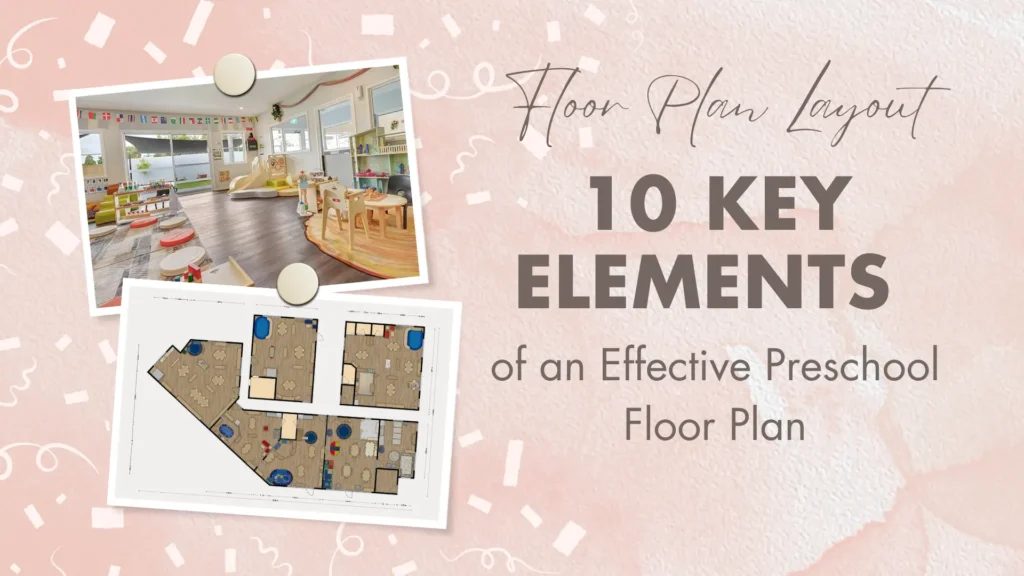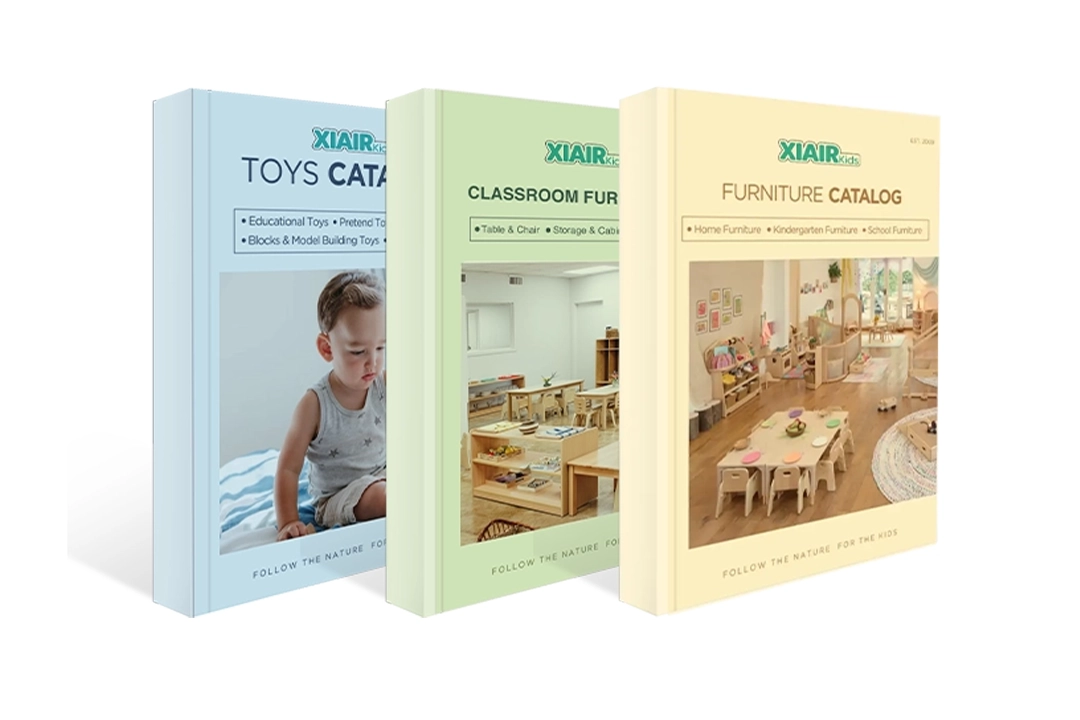Creating an effective preschool floor plan can be challenging. A well-designed layout not only promotes safety but also enhances learning and development. How can you ensure your preschool floor plan meets all necessary criteria?
An effective preschool floor plan balances safety, accessibility, and stimulation, creating an environment conducive to learning and growth. It’s essential to consider space utilization, furniture arrangement, and the specific needs of children.
Discover the critical elements that make a preschool floor plan effective.
The Role of Physical Space in Learning Development
When we consider the education of young children, the importance of a well-thought-out preschool floor plan cannot be overstated. Physical space is pivotal in learning development, influencing how children interact with their environment and how effectively they engage in educational activities. Here’s how a strategic preschool floor plan can make all the difference in fostering a conducive learning atmosphere.
- How Does Encouraging Movement and Exploration Aid Development?
- How Can a Preschool Floor Plan Facilitate Various Learning Styles?
- Why is Promoting Social Interactions Important in Early Education?
- How Do Safety and Comfort Influence Learning?
- What Role Does Stimulating Sensory Development Play in Early Childhood Education?
- How Can a Preschool Environment Adapt to Individual Needs?
In designing an effective preschool floor plan, the primary aim is to establish a balanced environment that supports structured activities and free play, which is crucial for fostering the holistic development of young minds. Such a plan should integrate spaces promoting cognitive skills through specific learning activities, creativity, and self-expression during unstructured playtime.
A well-conceived preschool environment addresses children’s physical, emotional, and educational needs, ensuring their safety and comfort. It provides a nurturing space that encourages exploration and interaction, which is fundamental for early learning and emotional growth. Additionally, the floor plan must be adaptable, allowing educators to tailor the learning spaces to the evolving needs of children as they grow and develop.
The best learning environments are dynamic and responsive, catering to the diverse needs of young learners and fostering their development in a secure and stimulating setting.
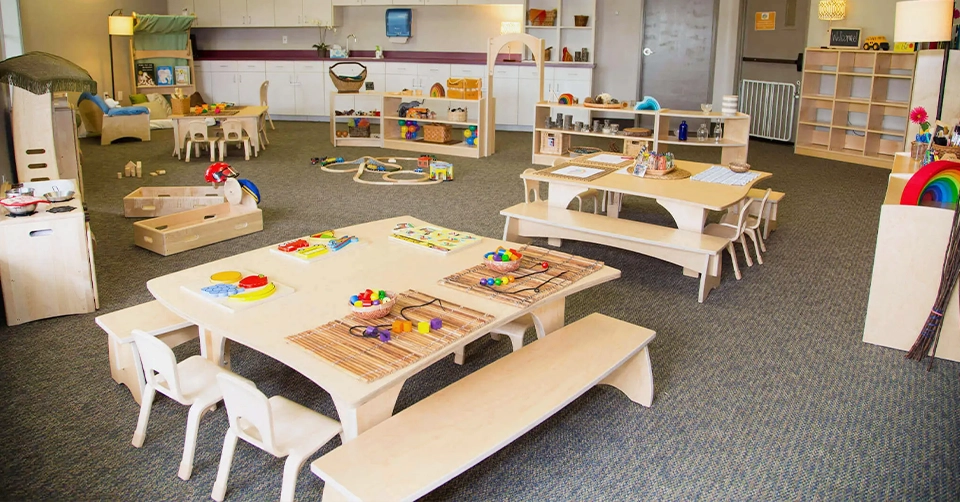
Steps to Plan an Effective Preschool Classroom Layout
Arranging Scaled Furniture for Independent Child Access
Children thrive in an environment that allows them to explore and access their materials independently. When arranging scaled furniture in your daycare classroom floor plan, include low-height shelves for toys and books, small tables, and chairs that match the children’s size. Daycare floor plans are designed to promote independence and encourage self-confidence.
For small daycare floor plans, modular furniture can help you adapt to limited space. For example, stackable chairs or collapsible tables can double as activity stations. This approach ensures every inch of the layout is functional.
Providing Sufficient Space for Behavior Management
A calm and open area for behavior management is a critical part of any daycare center floor plan. This space can be a corner with soft cushions, dim lighting, and sensory toys where children can calm down or take a moment to self-regulate. Including this in your daycare floor plan design supports children’s emotional needs and improves classroom dynamics.
Creating Distinct Learning and Development Stations for Preschoolers
Preschool classrooms benefit from having specific zones for various activities. Include these stations in your preschool classroom floor plan:
- Art Station: Provide easy access to paint, crayons, and craft supplies.
- Reading Nook: A quiet area with soft seating and books for independent or group reading.
- Sensory Play Station: Items like sand tables, water play bins, and textured materials.
- Dramatic Play Area: Props like costumes, toy kitchens, or cash registers for imaginative play.
Incorporate these stations into your daycare center floor plan layout for larger spaces to keep children engaged in different activities.
Adjusting Classroom Temperature for Comfort
Temperature control is an often overlooked aspect of daycare building floor plans. Ensure proper insulation in colder areas and ventilation in sunny spots. If pets are part of the classroom, such as fish tanks or hamsters, position them in climate-controlled zones for comfort. This adds to the overall functionality of your preschool floor plan design.
Critical Components of an Effective Preschool Layout
- Total Child Capacity: Define the maximum number of children your preschool can accommodate.
- Regular Visitor Count: Estimate the number of people visiting your center.
- Classrooms and Offices: Plan the required number of classrooms and administrative spaces.
- Staff Areas: Allocate specific areas dedicated to staff needs.
- Indoor Play Spaces: Design ample space for various indoor activities.
- Storage Areas: Ensure sufficient storage for educational materials and equipment.
- Kitchen and Meal Prep: Include a kitchen or designated area for food preparation.
- Safe Entry and Reception: Create welcoming yet secure entry and reception areas.
- Child-Accessible Furniture: Equip spaces with furniture and fixtures scaled for children.
- Behavior Management Areas: Set up spaces for quiet time and managing behavior.
- Learning Stations: Establish distinct areas for diverse learning activities like art, reading, and play.
- Pet-Friendly Spaces: Consider the needs of classroom pets, particularly regarding the environment.
Designing a preschool is about creating a safe, welcoming, and super functional space for everyone—kids, staff, and even the occasional pet! Start by figuring out how many little ones you can comfortably fit in and how many visitors will pop in regularly. You’ll need enough classrooms for the kids and office space for the team. Don’t forget about setting up cozy staff areas where they can catch a break.
Having plenty of room for all the fun is crucial—indoor play zones where kids can run free and be creative. And, of course, you’ve got to think about where all the toys, art supplies, and books will go, so lots of storage is a must. A kitchen space for snack time helps keep those little tummies happy.
Safety’s a big deal, too. Make sure the entrance and reception area are secure but still inviting. Furnish the place with easy things for kids to get to independently, fostering some independence. Having specific spots for time-outs or quiet time helps manage the occasional meltdown and keeps things running smoothly.
Set up different learning stations tailored for activities like reading, arts and crafts, or dramatic play to spark those young imaginations. And if you’re bringing a classroom pet into the mix, ensure their spot is comfy and safe.
Getting all these elements right makes your preschool not just a place to learn but where kids love to be—and that’s a win in my article!
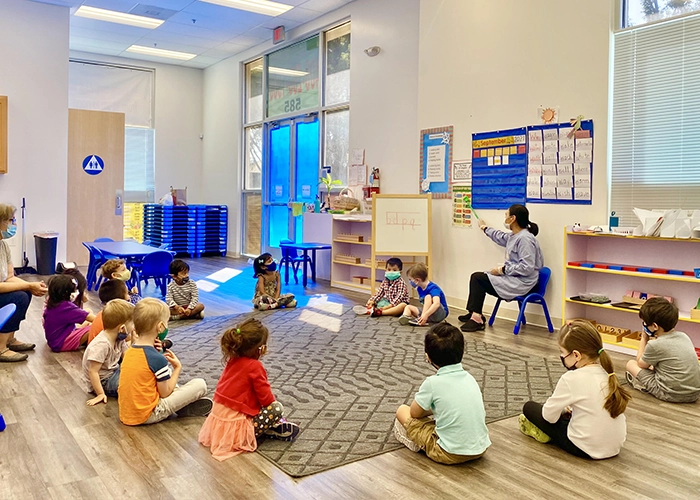
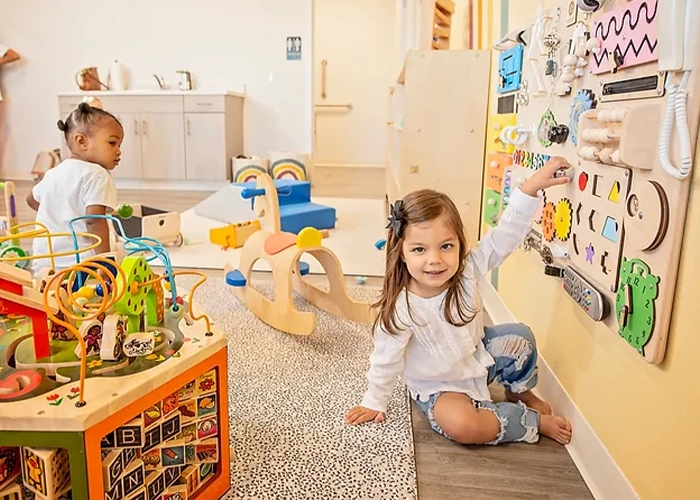
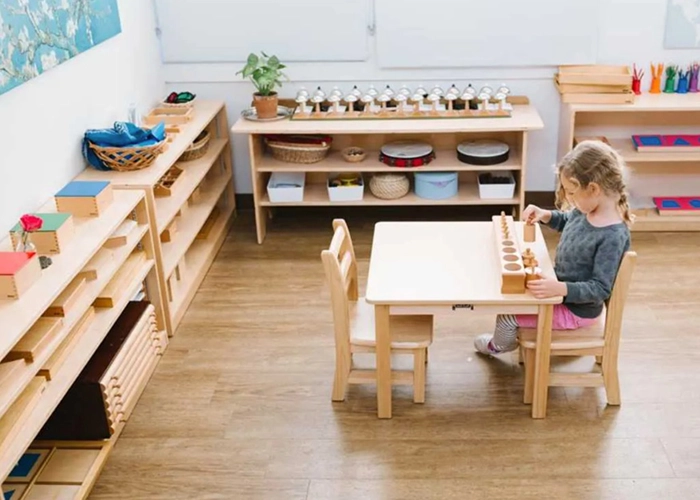
Daycare Room Setup Tips for a Functional Space
- Organizing Cubby Storage
Cubby storage helps maintain an organized classroom. Place cubbies near the entrance for easy drop-off and pick-up of personal items. This is an essential feature in small daycare center floor plans, where every bit of space needs to serve a purpose. - Efficient Classroom Storage
Innovative storage solutions are crucial for keeping supplies tidy yet accessible. Use labeled bins and stackable storage units in your daycare floor plans designs. Vertical storage systems work particularly well in home daycare layout floor plans. - Diaper Changing Station
The diaper changing station should be centrally located and close to the crib area. Include a countertop with storage underneath for wipes, diapers, and cleaning supplies. This feature is vital in infant daycare room floor plans for infant care. - Setting Up a Crib Area
Cribs should be spaced out to ensure safety and minimize disruptions. Use dividers or curtains to provide privacy for sleeping infants. For a functional floor plan of a daycare center, the crib area should be positioned away from noisy activity zones. - Creating a Nap Area
Arrange mats or cots in a quiet, dimly lit area for older children. A well-planned preschool daycare floor plan incorporates nap zones that help children recharge and stay focused for the rest of the day. - Feeding Area Setup
A feeding area should have child-sized tables and chairs to encourage proper eating posture. For small daycare floor plans, consider using foldable furniture to maximize the use of limited space. Cleanliness and accessibility are essential in this section of the layout. - Space for Developmental Play
Developmental play areas are the heart of any daycare outdoor playground floor plan. Include open spaces for running, building blocks, or group games. This setup enhances children’s physical and cognitive growth when combined with indoor play areas. - Open Activity Areas
Open spaces are essential for flexible lesson planning. Incorporate these areas into your preschool layout floor plan to accommodate activities like storytelling, dance, or singing. They should be free of clutter and adaptable for different uses.
Inspiring Preschool Floor Plan Layout Ideas for Different Program Sizes
The ideal layout for your preschool classroom will vary based on your educational objectives and the learning environment you envision for your students. It’s important to note that your classroom design can be updated as your program evolves. Even minor changes can significantly enhance the experience for teachers, children, and families. Below are some sample layouts, organized by program size, to help inspire your design process.
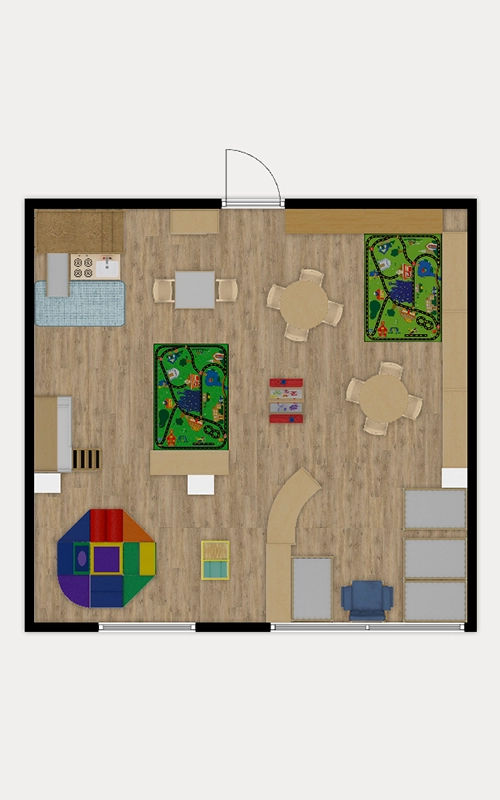
Small classroom layout ideas(36.4m²-8-10kids)
For a more minor program, the focus should be on creating a cozy and engaging environment that maximizes the use of limited space. Here are some key elements to consider:
- Multi-Functional Areas: Combine different activity zones to save space. For instance, a reading nook can also serve as a quiet area.
- Compact Storage: Use vertical storage solutions to keep materials organized and accessible without taking up too much floor space.
- Flexible Furniture: Choose furniture that can be easily rearranged to accommodate various daily activities.
Medium classroom layout ideas(67.2m²-20-36kids)
A medium-sized program allows for a bit more flexibility and the inclusion of specialized zones. Consider the following ideas:
- Dedicated Learning Zones: Create distinct areas for different activities, such as a science corner, an art station, and a dramatic play area.
- Interactive Spaces: Incorporate interactive elements like sensory tables and manipulative stations that encourage hands-on learning.
- Teacher Workstations: Ensure designated spaces for teachers to prepare materials and observe students.
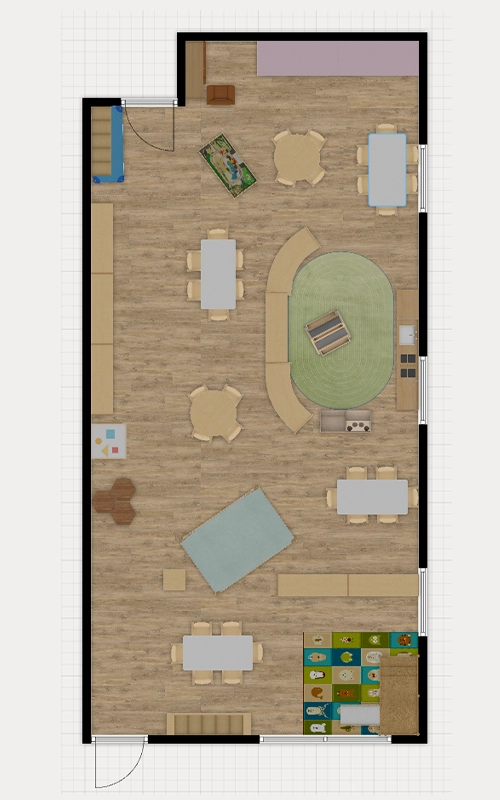
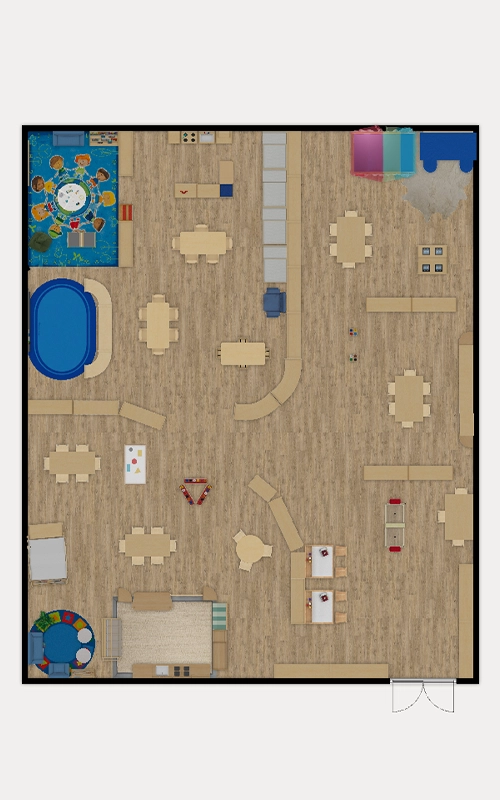
Medium classroom layout ideas(133.3m²-30-50kids)
For more extensive programs, the layout can be more elaborate, offering a wide variety of specialized areas to support diverse learning experiences:
- Themed Rooms: Consider dedicating entire rooms or large classroom sections to specific themes, such as a nature exploration area or a technology corner.
- Collaborative Spaces: Include areas where students can work together on group projects, fostering social interaction and teamwork.
- Outdoor Integration: Design spaces that seamlessly connect indoor and outdoor learning environments, allowing for activities like gardening and nature walks.
When designing your preschool classroom layout, there are fundamental principles to keep in mind, regardless of the size of your program. These principles ensure that the space is functional, safe, engaging, and adaptable to the evolving needs of your children, teachers, and the wider community.
How Much Space Does Each Child Require in a Daycare Layout?
Determining how much space each child needs is crucial when planning a daycare layout. According to industry standards:
- Indoor Space: Each child requires 35–50 square feet to ensure enough room for activities and movement.
- Outdoor Space: Allocate at least 75 square feet per child to accommodate physical activities like running, climbing, and group games.
For example, if your daycare has 20 children, you will need:
- 700–1,000 square feet of indoor space.
- 1,500 square feet of outdoor play area.
In small daycare floor plans, optimizing space through creative zoning and multi-use areas is critical. For instance, stackable furniture or foldable playstations can maximize functionality without compromising comfort. More extensive daycare center floor plans allow for dedicated zones such as reading corners, sensory play areas, and quiet zones, ensuring each child’s developmental needs are met.
By meeting these space requirements, you comply with regulations and create a comfortable, functional environment that supports children’s growth and learning.
Tips for All Sizes in Designing a Preschool Floor Plan
Prioritizing Safety in Your Preschool Floor Plan
Safety is the cornerstone of an effective preschool floor plan. Ensuring that every area is secure and accessible is crucial for creating a worry-free environment for children to explore and learn.
- Clear Pathways: Design your preschool floor plan with unobstructed pathways to allow children and teachers to move around quickly. Comprehensive, clear paths reduce the risk of accidents and help manage the flow of activities.
- Child-Friendly Materials: Use non-toxic and durable materials for all furniture and fixtures. Child-friendly materials ensure that the classroom remains safe and suitable for daily use.
- Visible Supervision: Arrange the layout so teachers can easily see all classroom areas. Open sightlines help maintain safety and allow for effective monitoring of children.


Incorporating Flexibility into Your Preschool Floor Plan
Flexibility is a critical component of a successful preschool floor plan. As your program’s needs change, the classroom should be adaptable to accommodate new activities and teaching methods.
- Movable Furniture: Select furniture that is lightweight and easy to move. This allows for quick reconfiguration of the space to suit different activities and learning styles.
- Multi-Use Areas: Design areas that can serve multiple functions. For example, a reading nook can also be used for quiet time or individual work, making the most of your available space.
- Future-Proof Design: Plan for potential growth and changes in your program. Incorporate adaptable elements that can evolve with your preschool’s needs, such as additional storage or flexible partitions.
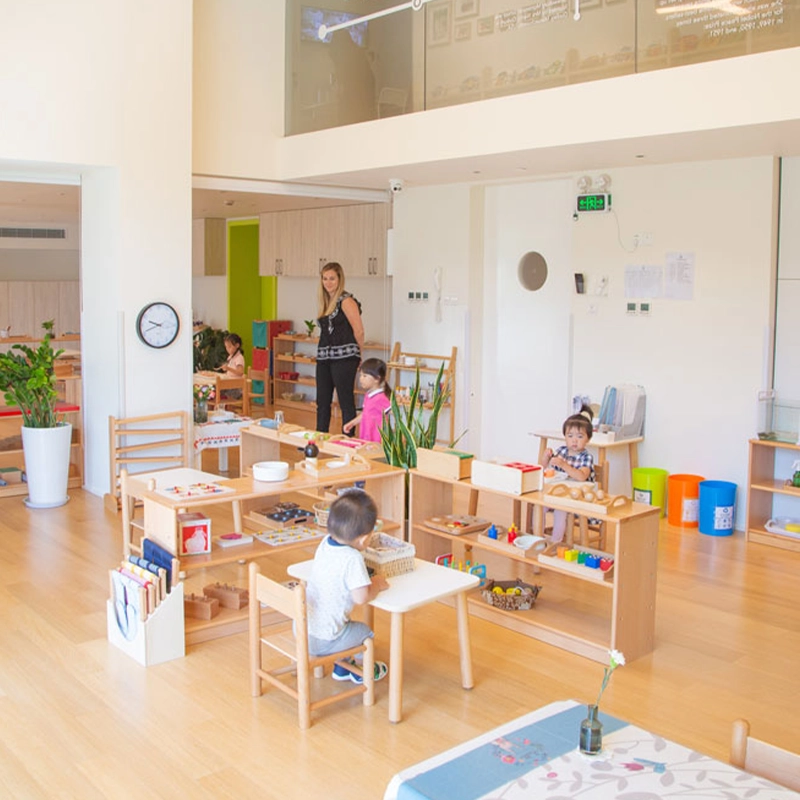
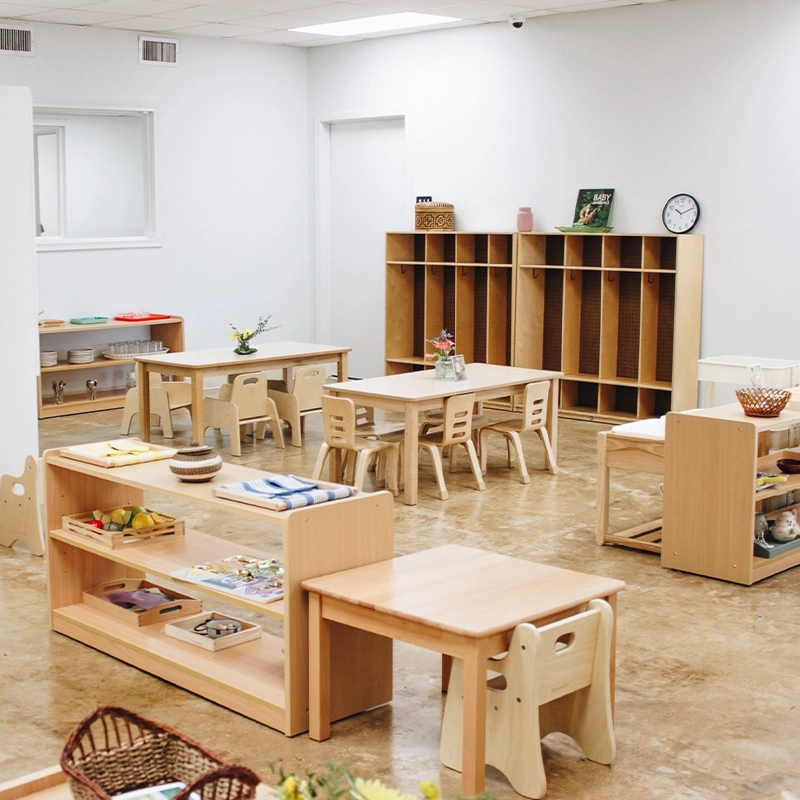
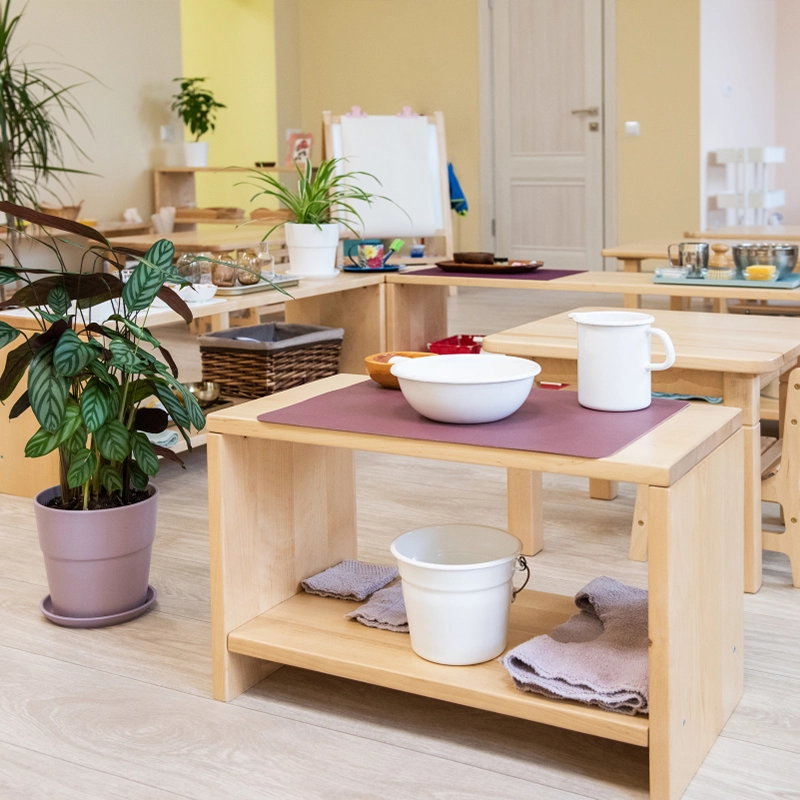
Creating Engaging and Stimulating Spaces
Engagement is vital for fostering a love of learning in young children. An engaging preschool floor plan includes various zones stimulating curiosity and encouraging active participation.
- Bright and Cheerful Decor: Use vibrant colors and playful decorations that attract children’s attention and make the space inviting. Displays should be at a child’s eye level to encourage interaction.
- Interactive Elements: Incorporate sensory tables, puzzles, and other hands-on materials that children can explore. Interactive elements make learning fun and engaging.
- Diverse Learning Zones: Create distinct areas for different activities, such as reading, art, and science. Each zone should have the necessary materials to support its focus, fostering diverse learning experiences.
Fostering a Sense of Community
A strong sense of community is essential in a preschool setting. Designing your preschool floor plan to include spaces for parents and community members helps build a supportive and collaborative environment.
- Parent Engagement Areas: Include comfortable areas where parents can wait, meet with teachers, or participate in classroom activities. A small lounge with seating and informative displays can make parents feel welcome and involved.
- Community Boards: Install bulletin boards or digital displays to inform parents and visitors about classroom activities, events, and announcements. This helps create a transparent and communicative atmosphere.
- Collaborative Spaces: Designate areas where children can work together on group projects. These spaces encourage teamwork and cooperation and can also be used for community projects that involve parents and local organizations.
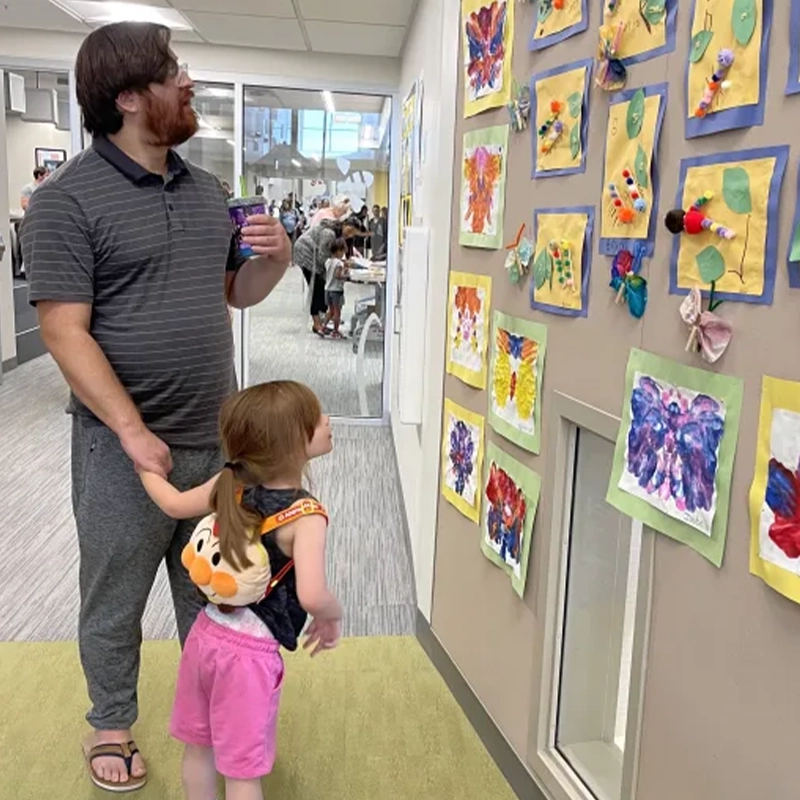
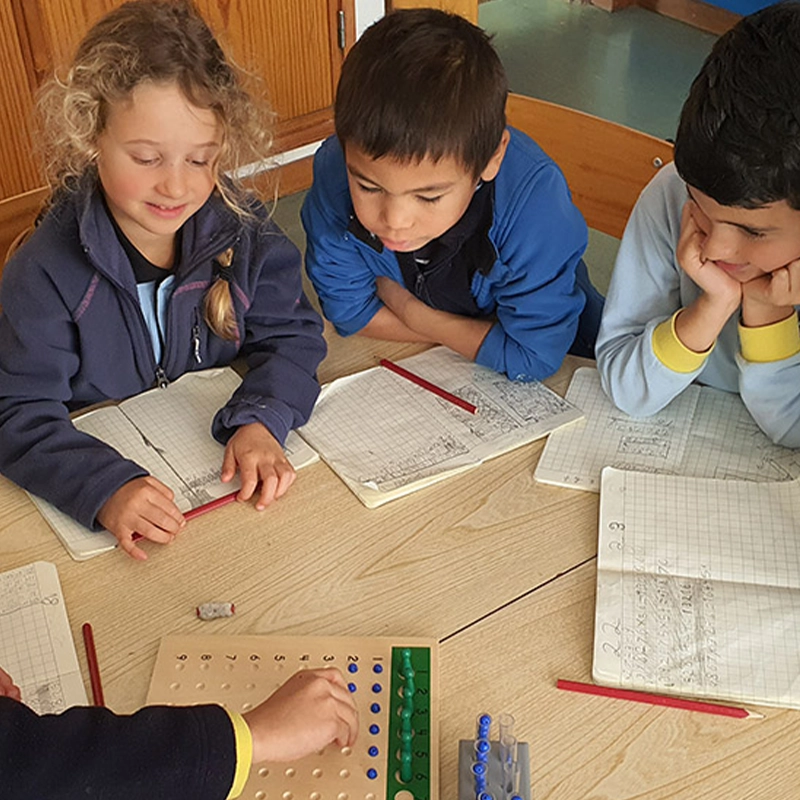
How Can a Preschool Floor Plan Be Made Inclusive?
An inclusive preschool floor plan ensures that every child can access and benefit from all available resources and activities regardless of ability or background. To achieve this, the floor plan should include wide pathways that accommodate children with mobility aids, sensory-friendly areas for those with sensory processing issues, and materials that reflect cultural diversity. Labels and signs should use simple language and include pictures to assist non-readers and non-native speakers. Additionally, activity areas should encourage collaboration and interaction among all children, fostering an environment of mutual respect and understanding.
What Types of Learning Zones Should Be Included in a Preschool Floor Plan?
A well-rounded preschool floor plan includes various learning zones, each designed to support different aspects of child development. Essential zones include:
- Creative Arts Area: This space allows for expression through drawing, painting, and crafting.
- Literacy Nook: A cozy corner with books and storytelling aids that promote reading and listening skills.
- Science and Exploration Space: Features natural elements and scientific tools that encourage curiosity about the physical world.
- Sensory Play Area: Contains materials like sand, water, and play dough that stimulate the senses and support fine motor development.
- Dramatic Play Area: Equipped with costumes and props for role-playing, which enhances language skills and creativity.
- Quiet Zone: A peaceful area where children can relax or engage in quiet activities, essential for downtime and emotional regulation.
Each zone should be clearly defined yet flexible enough to adapt to different activities or teaching methods.
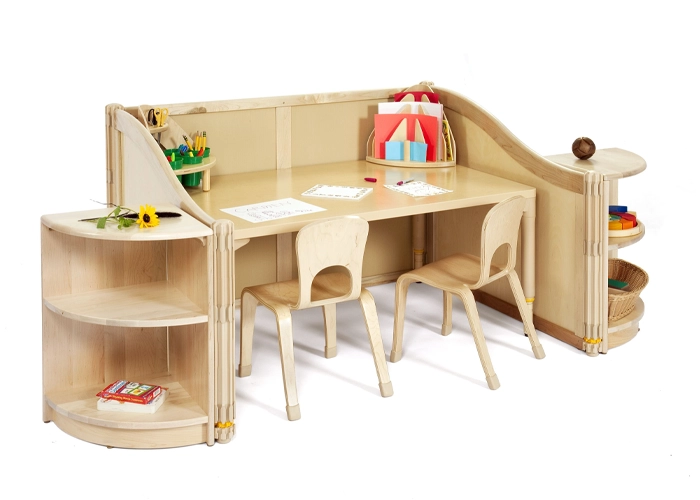
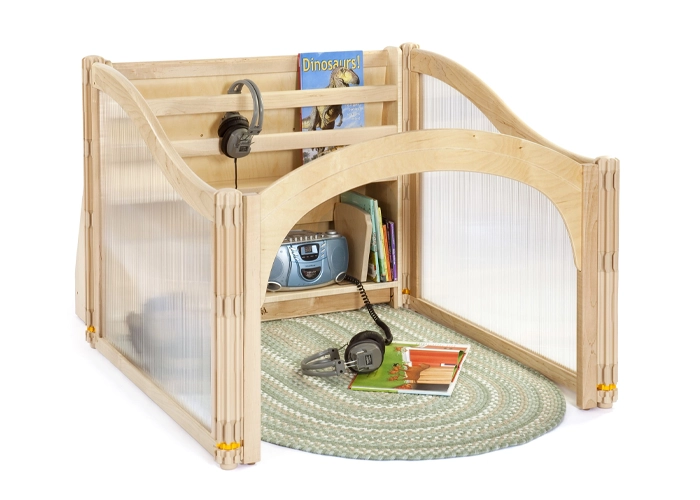
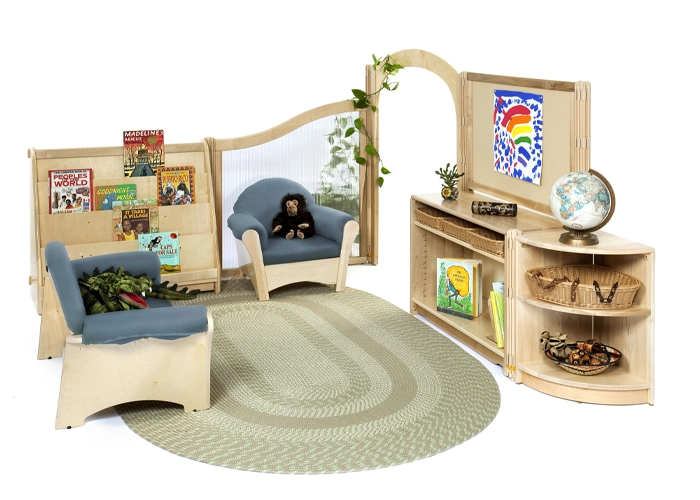
Enhancing Classroom Design with Outdoor Spaces
Outdoor spaces play a vital role in fostering holistic child development. By integrating features like climbing structures, bike tracks, and sandboxes into daycare outdoor floor plans, children gain opportunities for physical activity, sensory exploration, and social interaction.
Outdoor areas are not just for play—they can complement indoor learning activities. For example:
- Gardening Zones: Teach children about plants and sustainability while encouraging teamwork.
- Art Stations: Provide outdoor easels and natural materials like leaves or pebbles for creative projects.
- Quiet Corners: Set up shaded areas with benches or beanbags where children can relax or read.
Incorporating outdoor spaces into your daycare floor plan layout supports better airflow and light exposure, creating a healthier environment for children and staff. Schools with limited outdoor areas can still benefit by adding minor features like portable sensory tables or wall-mounted chalkboards near the building perimeter.
Professional Tip: Use modular play equipment that can be rearranged based on class size or seasonal needs, making your daycare outdoor floor plan more flexible and adaptable.
What Role Do Outdoor Spaces Play in a Preschool Floor Plan?
Outdoor spaces are vital to a preschool floor plan, providing unique learning and developmental benefits. These areas allow children to engage in physical activities, which are essential for health and motor skills development. Natural settings also stimulate children’s imagination and can be used for teaching concepts such as science and environmental awareness. Furthermore, outdoor spaces support social skills development as children learn to play cooperatively and negotiate game rules.
Including features such as gardens, play structures, and nature trails can significantly enrich the learning environment. These elements should be designed to be safe and accessible, allowing children to explore and learn in an open, health-promoting environment.
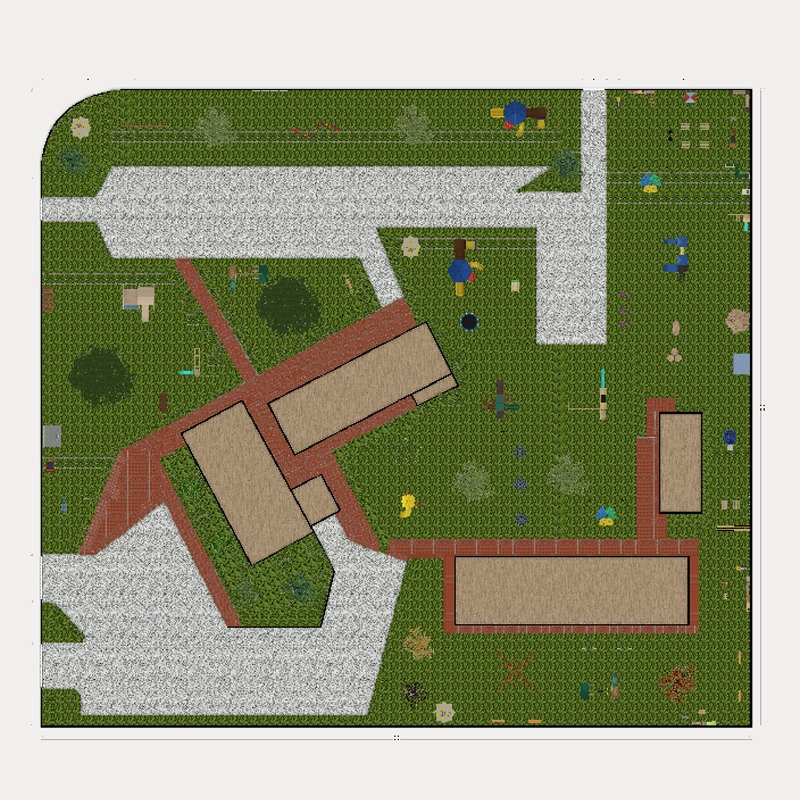
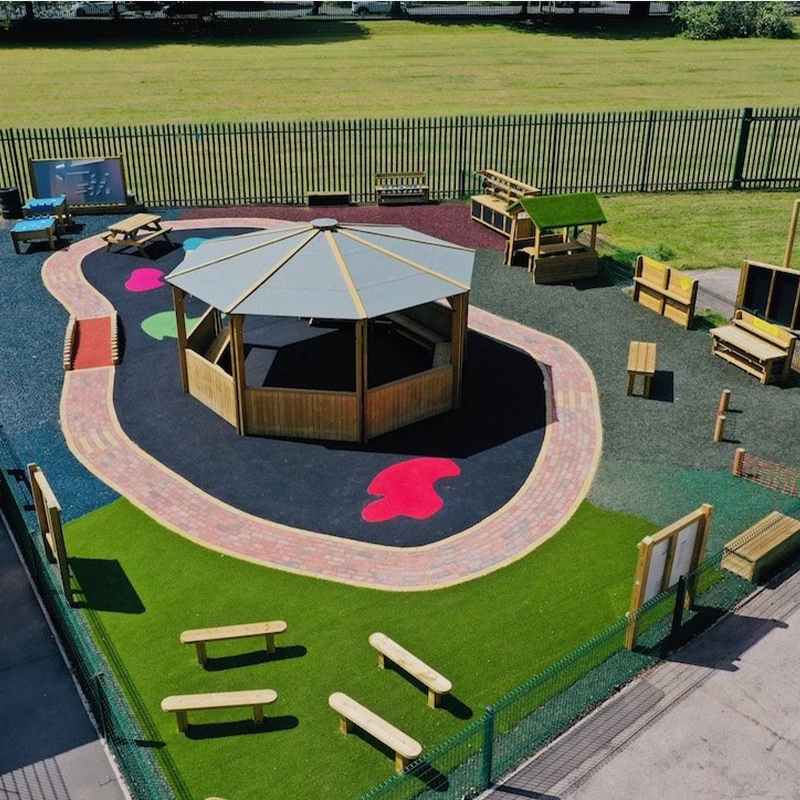
In conclusion, designing an effective preschool floor plan involves more than just allocating space. It requires a thoughtful approach incorporating inclusivity, diverse learning zones, and dynamic outdoor spaces. By doing so, you create a stimulating and supportive environment that caters to the educational needs of all children, laying a solid foundation for their future learning and development.
Designing a preschool floor plan that balances safety, flexibility, engagement, and community involvement creates a nurturing environment for young children. You ensure safety by prioritizing clear pathways, child-friendly materials, and visible supervision. Incorporating movable furniture and multi-use areas adds flexibility, while bright decor and interactive elements enhance engagement. Creating spaces for parent and community involvement fosters a strong sense of community. A thoughtfully designed preschool floor plan not only supports the holistic development of children but also adapts to the evolving needs of your program, ensuring a dynamic and enriching educational experience for all.
Incorporating these principles into your preschool floor plan will help you create a space where children thrive, teachers can effectively manage their classrooms, and parents feel connected and involved. By focusing on these key elements, you can design a functional and inspiring preschool, setting the stage for a successful and fulfilling learning journey.
Planning a Budget for a High-Quality Preschool Design
Designing a high-quality preschool layout doesn’t have to strain your budget. A strategic approach involves prioritizing key elements and using resources effectively. Start by identifying essential areas, such as:
- Learning Stations: Modular desks and shelves that adapt to changing class sizes.
- Storage Solutions: Affordable options like cubbies and stackable bins for maximizing vertical space.
- Play Zones: Multi-purpose equipment that accommodates both developmental play and structured lessons.
To reduce costs, utilize free tools like a daycare floor plan creator free, which allows you to visualize and adjust your layout without hiring expensive consultants. For small daycare floor plans, focus on maximizing usable space by combining areas (e.g., a dining area that doubles as a craft space).
Cost-Saving Tips:
- Repurpose Furniture: Convert unused home furniture into daycare essentials, such as converting a bookshelf into a storage station.
- Invest in Multi-Use Items: Purchase tables as nap areas or activity stations.
- Plan for Scalability: Design your layout with future expansions in mind, particularly if you plan to transition from a small daycare floor plan to a larger daycare center floor plan.
Sources for Free Daycare Floor Plan Tools and Ideas
Creating the perfect daycare or preschool floor plan can be overwhelming, but you don’t have to tackle it alone. At Xiair World, we provide a wide range of free tools and personalized services to help you design and optimize your daycare layout. Here’s how we can assist you:
Free Daycare Floor Plan Templates
Our website offers detailed floor plan examples tailored for daycare centers, preschools, and home daycare setups. These templates are designed to meet international safety standards while ensuring maximum functionality. You can explore options that suit your unique requirements, whether working with a small daycare floor plan or a large, multi-classroom center.
Don’t just dream it, design it! Let’s chat about your custom furniture needs!
Customized Layout Design Assistance
Not sure how to organize your space? Please take advantage of our free classroom planning service, where our experts help you design layouts that maximize space efficiency and meet your educational goals. From 2D and 3D models to precise cost breakdowns, we ensure you have a complete picture before making any decisions.
Access Our Product Catalog
Our catalog features classroom furniture, including cubby storage, modular desks, and ergonomic seating. Each piece is designed to fit seamlessly into your daycare or preschool floor plan. Visit our category to request your free catalog and explore innovative ideas for creating an inspiring learning environment.
Your perfect classroom is one click away!
Expert Guidance Every Step of the Way
With over 20 years of experience, Xiair World is committed to supporting educators and daycare operators in designing functional and creative learning spaces. We’ve helped thousands of centers worldwide bring their floor plans to life, combining high-quality products with thoughtful planning. Let us help you quickly and efficiently turn your daycare floor plan ideas into reality!

